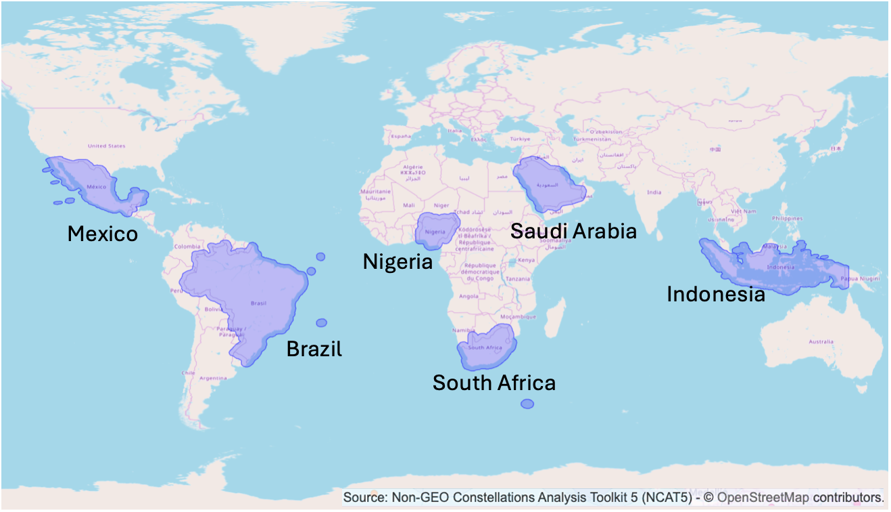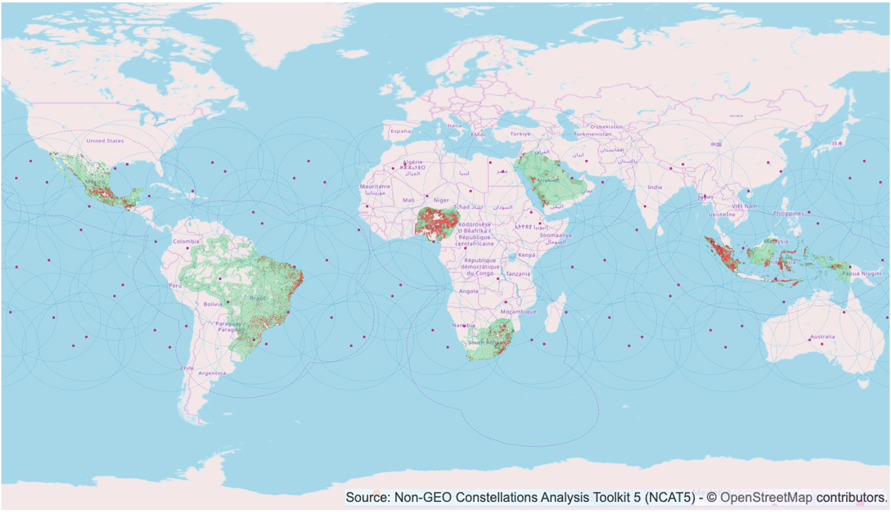Nations with LEO sovereignty ambitions should revisit lessons from past space co-operation
02 October 2025 | Research and Insights
Article | PDF (4 pages) | Earth Observation| Government and Military Space| Satellite Capacity| Satellite Mobility| Satellite–Telecoms Integration| Space Ground Segment| Space Infrastructure
The low-Earth orbit (LEO) satellite market is approaching a new frontier where connectivity is global and governmental players see space as a strategic connectivity domain. LEO sovereignty is now closely tied to national interests; yet LEO viability can still appear distant given technical, financial and regulatory considerations. These challenges in LEO call for a strategic rethink, and the solution may lie within a model developed over 60 years ago: Intelsat and coalition building.
SES’s acquisition of Intelsat is now finalised, and so the moment is ripe to reflect on the historical foundations of global satellite communications (satcom) and consider how they can shape today’s dynamic LEO landscape. History seldom repeats itself, but nations looking to the future in LEO must learn from the past to build a viable, sustainable LEO strategy.
GEO coalition building provided a strategic roadmap
Intelsat was established by 11 countries as an intergovernmental organisation in 1964. It was inspired by President John F. Kennedy’s peaceful vision of outer space, as outlined in his 1961 address to the United Nations, which called for a co-operative global satcom system. Though he did not live to see the launch of Intelsat I (‘Early Bird’) in 1965, Kennedy helped lay the groundwork for a multilateral approach to space infrastructure, one that combined diplomacy, technology and a long-term strategic vision.
Geostationary (GEO) satcom was born during the Cold War-era space race. We now find ourselves in a new space race focused on LEO constellations. This time, however, the field is more crowded and the pace far more accelerated, with the private sector taking a dominant role.1 Unlike Intelsat’s intergovernmental foundation, today’s LEO ventures are largely commercial, attracting massive private capital and driving fast-paced innovation.
Despite these differences, the Intelsat model serves as a powerful reminder: international collaboration can create resilient, scalable and sustainable infrastructure. The coalition-building that enabled Intelsat to dominate the GEO communications landscape for decades could hold the key to responsibly developing LEO, particularly for countries beyond the space superpowers of the USA, China, the EU and Russia.
LEO sovereignty can benefit from new coalition building
Sovereign LEO constellations are often driven by national objectives ranging from strategic autonomy to digital inclusion and economic development. However, national ambition alone is not enough. Long-term viability depends on an operator’s ability to access broader markets and achieve efficiencies through collaboration.
A previous study conducted using our Non-GEO Constellations Analysis Toolkit (NCAT) concluded that the success of sovereign LEO systems will be determined by how nations balance sovereignty with interdependence. The analysis found that purely domestic deployments often fail to deliver economic sustainability due to underutilisation and fragmented demand. In contrast, cross-border coalitions can unlock the scale needed for commercial viability.
To explore this further, Analysys Mason conducted a new NCAT5 simulation under the same baseline assumptions as in prior work, but with one key variation: we modelled a coalition approach across six emerging economies, namely Brazil, Mexico, Nigeria, South Africa, Saudi Arabia and Indonesia.2
Figure 1: Geographical scope of NCAT simulation (including national boundaries plus a 150km adjoining belt)

These countries share several common characteristics:
- Relatively large and growing economies
- Rapid digitalisation, yet with broadband-access gaps
- Active national digital strategies, often with public-private partnerships
- Membership or alignment with major geopolitical blocs such as the G20
Despite their different geographies and digital maturity levels, all of the six countries face the challenge of delivering affordable, inclusive broadband connectivity, especially to underserved rural and suburban populations.
NCAT simulation findings present a positive outlook
We found in prior modelling that a (hypothetical) sovereign-only constellation over Saudi Arabia struggled to meet breakeven requirements, even with optimal national resource allocation. Structural inefficiencies such as low global fill rates and underutilised capacity were significant barriers.
Building on that, Analysys Mason undertook its new NCAT5 analysis using identical technical assumptions but expanding the addressable market through a six-country LEO coalition. Notably, the constellation’s technical characteristics and the spatial separation of these countries minimised demand overlaps, which in turn improved asset utilisation.
Figure 2: Snapshot of NCAT dynamic constellation analysis showing real-time supply and demand balance

This new LEO coalition model produced impressive results. The breakeven bandwidth cost for the constellation dropped to below USD27 per Mbit/s per month, with approximately 350 000 user terminals in rural areas of the six countries. This is an order of magnitude lower than in the single-country scenario and is competitive with current benchmarks from commercial operators.
The constellation’s total capacity exceeds 6.6Tbit/s and 26% of the capacity becomes useable. Therefore, the global fill rate substantially increases compared to only 3–4% under a single-country scenario.
This result reinforces the hypothesis that coalition-based sovereignty can deliver both strategic and economic value in the LEO domain, especially for nations that might otherwise lack the scale to compete with mega-constellations launched by global tech giants.
Key highlights
- History matters. The Intelsat model shows how international co-operation can build enduring space infrastructure, a valuable precedent for today’s LEO ecosystem.
- New space race, new rules. Today’s LEO race is private-sector-driven and multi-polar, unlike the state-led telecoms and GEO era. However, national interest still plays a central role.
- Emerging market opportunity. Countries such as Brazil, Mexico, Nigeria, South Africa, Saudi Arabia and Indonesia are digitally ambitious but face access gaps. This makes them good partners for coalition-based constellations.
- From sovereignty to solidarity. Sole national constellations often face cost and efficiency limitations. Multi-country coalitions can reduce cost-per-bit, expand market reach and ensure more inclusive digital growth.
- Breakeven improved tenfold. A coalition approach reduced the breakeven cost to under USD27/Mbps/month in NCAT simulations. This is comparable to commercial benchmarks and is far more viable than sovereign-only efforts.
Strategically structured sovereign LEO coalitions could follow a similar trajectory as Intelsat, which ultimately expanded from a small group of visionary nations to a global alliance of over 140 member countries. This time, however, the opportunity is amplified by technologies such as space-based lasers, decentralised network management and quantum key encryption – tools that can provide ‘virtual sovereignty’ without compromising interoperability or sustainability.
What starts with a handful of aligned nations, united by common needs and forward-looking strategies, can build the kind of momentum that reshapes space connectivity.
Analysys Mason has over 30 years' experience of providing space research, insights and strategic advisory to clients throughout the value chain. From market assessments and data-driven analyses to complete space strategy development, we have extensive expertise in helping our clients navigate the rapidly evolving space domain. For more information on our space capabilities, please visit Space Industry Consulting and Research Services | Analysys Mason.
This article was authored with the support of Carlos Placido.
1 For more information, see Analysys Mason’s Capabilities and Limitations of Non-GEO Constellations.
2 No confidential or proprietary data was used for this NCAT-supported article. Upon request, an expanded report is available for NCAT users, including detailed simulation documentation, satellite payload specifications and output data files in CSV format (7713 hi-res grid cells).
Article (PDF)
DownloadAuthor

Christopher Baugh
Partner, expert in space and satellite telecomsRelated items
Article
D2D services must balance capabilities, expectations and willingness to pay
Predictions
Predictions for the space industry in 2026
Podcast
Military satcom and commercial capacity integration: why secure orchestration matters

